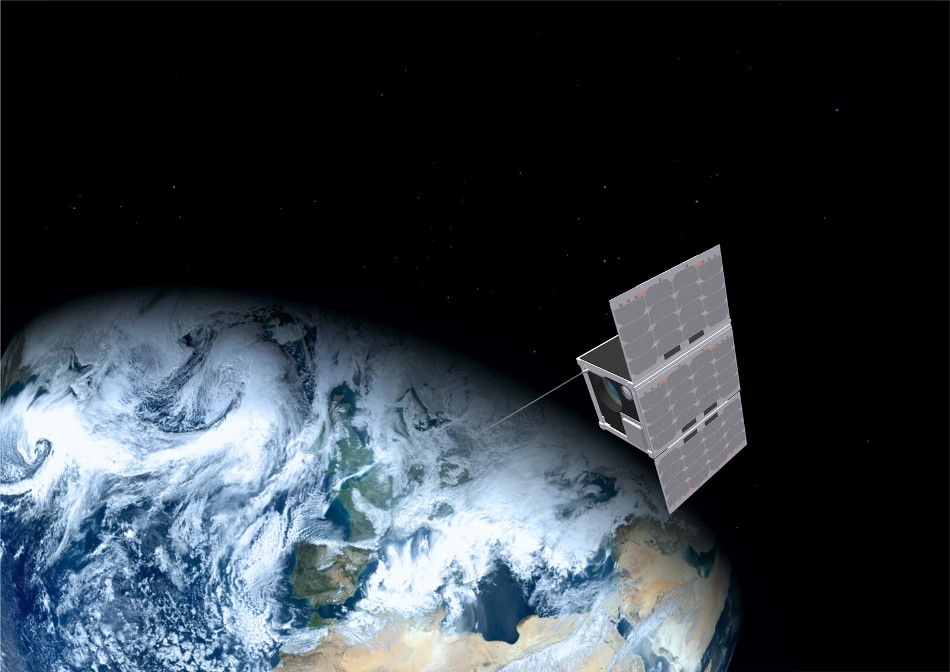Apr 11 2018
The low Earth orbit looks more like a congested junkyard. Burned-out rocket stages, disused satellites, and thousands of pieces of debris from collisions present a serious danger threat to the infrastructure in space.
Fraunhofer scientists have designed an innovative radar system and other technologies to enhance the protection of spacecraft against space junk. Not just this: the researchers have also developed an agile small satellite to make access to space more cost-effective and quicker.
 The small satellite ERNST is roughly the size of a shoe box and carries an infrared camera for Earth observation. (Image credit: Fraunhofer EMI)
The small satellite ERNST is roughly the size of a shoe box and carries an infrared camera for Earth observation. (Image credit: Fraunhofer EMI)
Scraps of wreckage speeding around in space pose a serious threat to everything that moves there. If the debris has to be avoided, it is important to know its exact location.
“Using the new GESTRA surveillance radar, it is possible to detect objects and debris in low Earth orbit up to 3000 kilometers,” stated Helmut Wilden, Team Leader for Multifunctional RF Sensor Technology at the Fraunhofer Institute for High Frequency Physics and Radar Techniques FHR in Wachtberg near Bonn.
GESTRA has the ability to scan large areas of space round the clock, and the TIRA radar system can observe individual objects more closely.
“GESTRA monitors the expanses of space to establish whether—and indeed how many—objects there are. TIRA can then produce an image of the individual objects, enabling them to be analyzed in more detail,” explained Jens Fiege, Head of Internal and External Communications at Fraunhofer FHR.
Furthermore, the sensitive antennae of TIRA enable it to detect objects with sizes of merely a few centimeters in size and larger, thereby allowing it to precisely measure their trajectories.
Vulnerability Analyses and Smart Design
When it is impossible to avoid collisions with debris, smart designs and robust materials help protect satellites against serious impairment. The innovative PIRAT software from the Fraunhofer Institute for High-Speed Dynamics, Ernst-Mach-Institut, EMI, in Freiburg calculates the ability of the satellite design or individual components to endure a collision. By design, PIRAT takes into account the flight path of the planned mission and the particle impacts to be anticipated in that region. Integrating the experimental simulation of collisions, the scientists at Fraunhofer EMI develop fact-based vulnerability analyses and protection concepts.
PIRAT makes it possible to determine the failure probability of individual components - even inside the satellite - if a piece of space junk pierces the external wall upon collision and spreads out as a cloud of fragments. Through the clever placement of components and the adding of thin protective layers, you can find a safe design with minimum impact on the overall system.
Dr. Martin Schimmerohn, Fraunhofer EMI
Small Satellite with 3D-Printed Component
The advanced Fraunhofer technologies will make travel to space in the future not only safer but also more cost-effective and faster. In the form of ERNST, researchers at Fraunhofer EMI have designed a small satellite that is multifunctional, reliable, and lightweight, which will reduce the development costs as well as the time-to-orbit.
Generally, several small satellites ride piggyback with large launch vehicles—this allows even small groups of researchers with limited financial resources to carry out tests in space. In research, this is an important step forward for us.
Thomas Loosen, Head of the Fraunhofer Space Alliance Administrative Office
Despite the fact that small satellites do not have the ability to transport any heavy payloads, they can be interlinked to form larger constellations, thereby allowing them to offer services such as high-quality global Earth observation coverage.
When ERNST is taken into orbit in 2021, it will be equipped with an infrared camera for Earth observation. It is an intriguing aspect that the camera is mounted on a unique bracket called an optical bank, which was produced with the help of metallic 3D printing technology. The 3D printing techniques not only provide innovative and nearly unrestricted design freedom but also reduce the production times. Earlier, the use of these techniques was very limited in the space sector due to the stringent quality and safety standards. The ERNST nanosatellite can now be used by the scientists at Fraunhofer EMI as a test platform for demonstrating this promising technology of the future.
The ERNST nanosatellite with infrared camera will be presented at the ILA Berlin Air Show from April 25 to 29, 2018, at the Joint Fraunhofer Booth No. 202 in Hall 4. There, models of the GESTRA and TIRA radar systems will be exhibited, demonstrating the PIRAT software and much more. Experts will be available for interviews, to answer questions, and to provide detailed explanations.